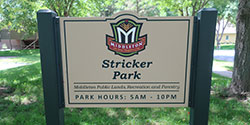Stricker's Pond

| Address: | 7214 Longmeadow Rd. |
| Hours: | 4:00am - dusk |
| Park Type:> | Conservation |
| Acres: | 13.49 |
| Restroom: | No |
| Drinking Water: | No |
Park History
The pond system started to change with agricultural cultivation of the surrounding uplands in the 1870's. Plowed fields resulted in increased runoff and sedimentation. More dramatic changes occurred when the landscape was subsequently converted to residential development. The huge increase in impervious surfaces (areas which don't allow water to infiltrate, such as sidewalks, streets, driveways, house roofs) increased the amount of stormwater runoff reaching the pond. Rather than being absorbed by the ground and slowly released through the water table, more rainwater now flows directly to the pond. Finally, a series of very wet years in the 1990's increased water levels dramatically. Subsequent recurring periods of intense rainfall events, such as June 2008 and August 2018, have eliminated emergent plants, killed surrounding trees, exacerbated excessive algae growth, and raised flooding concerns.To alleviate these problems, in 2000, the City of Middleton and the City of Madison cooperated to implement a plan that included construction of a forebay on the south end of Stricker's Pond to capture incoming sediment. This plan also called for construction of a water control structure at the northeast corner of Stricker's Pond to manage water levels and allow drainage to Tiedeman's Pond. From Tiedeman's Pond, excess water is then pumped to the storm sewer system that drains to Lake Mendota. After project completion, seven species of native emergent wetland plants were established through volunteer plantings, but only American lotus has managed to survive.
While these engineered features created a drainage outlet and reduced sedimentation, water quality is still impaired in this highly urbanized 557-acre watershed. Contributing to the problem is a newly introduced population of goldfish. Related to carp, goldfish feed on the pond bottom, stirring sediment and nutrients into the water column, which further exacerbate poor water quality. The goldfish population is also partly to blame for the low diversity and abundance of aquatic plants and macroinvertebrates observed in recent years.
At this Park
-
 Dog Free Park
Dog Free Park
Leashed and licensed dogs are allowed in all general Madison parks. There are a few notable exceptions as detailed in MGO 8.195 and highlighted on this page.
- All dogs must be licensed.
- All dogs must have a valid daily or annual Dog Permit.
- All owners must pick up their dog's waste.
- All dogs must be leashed and under the owner's control at all times. MGO 23.32(1)
- Violators may see a fine up to $500
- Violators may see a fine up to $500
Dog Prohibited Areas
(See MGO 8.195)- Conservation parks
- Burial mounds within 20 feet
- City of Madison Golf Courses (during the golf season)
- Olbrich Botanical Gardens
- Playgrounds and areas within 20 feet of a playground surface
- Splash parks, fenced areas(s) surrounding a splash park, and areas within 20 feet of the splash park surface
- Goodman Pool and Breese Stevens Field (except for special events where dogs are specifically invited)
- Programmed sports fields and facilities that are enclosed or substantially enclosed by a fence, whether in use or not
- Programmed, non-fenced sports fields such as soccer, ultimate fields or softball/baseball diamonds while they are in use for programmed activities
- Inside park shelters or other City buildings
- Groomed cross-country ski trails
- In the water or on the beach at designated beach locations
- Park special events except where the sponsor has requested to allow dogs, with the Park Superintendent's approval
-
Stricker's Pond - Dog Free Park
Location: 7214 Longmeadow Rd.
-
 Hiking
Explore the many scenic trails and pathways throughout Madison Parks. Year-round restrooms are available at Cherokee Marsh, North and Owen conservation parks.
Hiking
Explore the many scenic trails and pathways throughout Madison Parks. Year-round restrooms are available at Cherokee Marsh, North and Owen conservation parks.
MAPS
Looking for a trail map for a particular park? A number of the individual park pages provide a trail map. Check out the "About This Park" section of your favorite park. Don't see a map? Let us know!
Dogs
Most parks allow leashed & licensed dogs with a Dog Permit. However, dogs are prohibited in all conservation parks and a few other locations. See Dog Free Parks for more information. View all Hiking
About This Park
Get to This Park
Conservation Park Rules
Conservation Parks are uniquely managed to further protect native species and wildlife. The preservation of conservation parks includes some of the following. More information may be found in Madison General Ordinances 8.40.
Alcohol
Alcohol is prohibited in all conservation parks.
Bicycles & Motor Vehicles
Bicycles and motor vehicles are restricted to entrance roads and parking lots.
Dogs
Dogs and horses are not allowed.
Fire
Fires and picnics are prohibited.
Firearms
No firearms or weapons are permitted in the restrooms or shelters. Violators are considered trespassers and subject to forfeiture or arrest.
Glass
Glass is not allowed.
Hunting & Trapping
Hunting and trapping are prohibited.
Open Hours
Conservation park hours are 4am until one hour after sunset.
Plants
All plants and animals are protected. Disturbance or removal requires written permission.
Trails
Stay on and use designated trails only.
Trash & Recycling
Place trash in container provided. Please take recyclable material home for proper disposal.



